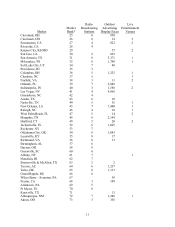iHeartMedia 2001 Annual Report Download - page 21
Download and view the complete annual report
Please find page 21 of the 2001 iHeartMedia annual report below. You can navigate through the pages in the report by either clicking on the pages listed below, or by using the keyword search tool below to find specific information within the annual report. 21
documents in their public inspection files - either on station websites or the websites of state
broadcasters’ associations.
Equal Employment Opportunity. In April 1998, the U.S. Court of Appeals for the D.C. Circuit
concluded that the affirmative action requirements of the FCC’s Equal Employment Opportunity
(“EEO”) regulations were unconstitutional. The FCC adopted new EEO affirmative action rules in
January 2000, but the same court of appeals struck down the new rules in January 2001. Accordingly,
broadcasters are currently not subject to FCC-imposed EEO regulations other than the general obligation
not to engage in employment discrimination based on race, color, religion, national origin or sex. In
December 2001, however, the FCC solicited public comment on yet another set of new EEO affirmative
action rules and policies that the agency believes would be constitutional. This proceeding is currently
pending.
Digital Audio Radio Service. The FCC has adopted spectrum allocation and service rules for
satellite digital audio radio service. Satellite digital audio radio service systems can provide regional or
nationwide distribution of radio programming with fidelity comparable to compact discs. The FCC has
authorized two companies to launch and operate satellite digital audio radio service systems. Sirius
Satellite Radio Inc. has launched three satellites and began commercial service in a few cities in February
2002. XM Radio has launched two satellites and is currently providing nationwide service. The FCC is
currently considering what rules to impose on both licensees’ operation of terrestrial repeaters that
support their satellite services. The FCC also has undertaken an inquiry regarding rules for the terrestrial
broadcast of digital radio signals, addressing, among other things, the need for spectrum outside the
existing FM band and the role of existing broadcasters. A technical standard for the provision of
terrestrial digital radio broadcasting has been developed and is currently before the FCC for approval.
We cannot predict the impact of either satellite or terrestrial digital audio radio service on our business.
Low Power FM Radio Service. In January 2000, the FCC created two new classes of
noncommercial low power FM radio stations (“LPFM”). One class (LP100) will operate with a
maximum power of 100 watts and a service radius of about 3.5 miles. The other class (LP10) will operate
with a maximum power of 10 watts and a service radius of about 1 to 2 miles. In establishing the new
LPFM service, the FCC said that its goal is to create a class of radio stations designed “to serve very
localized communities or underrepresented groups within communities.” The FCC has begun accepting
applications for LPFM stations and has granted some of these applications. In December 2000, Congress
passed the Radio Broadcasting Preservation Act of 2000. This legislation requires the FCC to maintain
interference protection requirements between LPFM stations and full-power radio stations on third-
adjacent channels. It also requires the FCC to conduct field tests to determine the impact of eliminating
such requirements. We cannot predict the number of LPFM stations that eventually will be authorized to
operate or the impact of such stations on our business.
Other. The FCC has also adopted rules on children’s television programming pursuant to the
Children’s Television Act of 1990 and rules requiring closed captioning and video description of
television programming. The FCC has also taken steps to implement digital television broadcasting in
the U.S. Furthermore, the 1996 Act contains a number of provisions related to television violence. We
cannot predict the effect of the FCC’s present rules or future actions on our television broadcasting
operations.
























